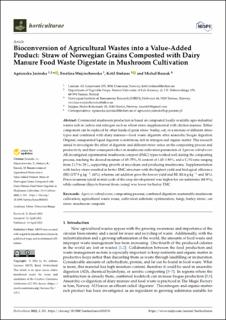| dc.contributor.author | Jasinska, Agnieszka | |
| dc.contributor.author | Wojciechowska, Ewelina Anna | |
| dc.contributor.author | Stoknes, Ketil | |
| dc.contributor.author | Roszak, Michał | |
| dc.date.accessioned | 2022-07-18T15:41:47Z | |
| dc.date.available | 2022-07-18T15:41:47Z | |
| dc.date.created | 2022-05-19T12:57:44Z | |
| dc.date.issued | 2022-04-14 | |
| dc.identifier.citation | Horticulturae. 2022, 8 (4), 1-14. | en_US |
| dc.identifier.issn | 2311-7524 | |
| dc.identifier.uri | https://hdl.handle.net/11250/3006431 | |
| dc.description.abstract | Commercial mushroom production is based on composted locally available agro-industrial wastes rich in carbon and nitrogen such as wheat straw supplemented with chicken manure. Either component can be replaced by other kinds of grain straw: barley, oat, or a mixture of different straw types and combined with diary manure—food waste digestate after anaerobic biogas digestion. Original, unseparated liquid digestate is nutritious, rich in nitrogen and organic matter. This research aimed to investigate the effect of digestate and different straw ratios on the composting process and productivity and their consequent effect on mushroom cultivation parameters of Agaricus subrufescens. All investigated experimental mushroom compost (EMC) types worked well during the composting process, reaching the desired moisture of 65–75%, N content of 1.43–1.93%, and a C/N ratio ranging from 21.5 to 29.1, supporting growth of mycelium and producing mushrooms. Supplementation with barley straw resulted in better EMC structure with the highest yield and biological efficiency (BE) (157.9 g kg−1; 64%), whereas oat addition gave the lowest yield and BE (88.6 g kg−1 and 38%). Precociousness (yield at mid-cycle of the crop development) was higher for oat substrates (68.9%), while earliness (days to harvest from casing) was lower for barley EMC. | en_US |
| dc.language.iso | eng | en_US |
| dc.publisher | MDPI, Basel, Switzerland | en_US |
| dc.rights | Navngivelse 4.0 Internasjonal | * |
| dc.rights.uri | http://creativecommons.org/licenses/by/4.0/deed.no | * |
| dc.title | Bioconversion of Agricultural Wastes into a Value-Added Product: Straw of Norwegian Grains Composted with Dairy Manure Food Waste Digestate in Mushroom Cultivation | en_US |
| dc.title.alternative | Bioconversion of Agricultural Wastes into a Value-Added Product: Straw of Norwegian Grains Composted with Dairy Manure Food Waste Digestate in Mushroom Cultivation | en_US |
| dc.type | Peer reviewed | en_US |
| dc.type | Journal article | en_US |
| dc.description.version | publishedVersion | en_US |
| dc.rights.holder | © 2022 by the authors | en_US |
| dc.source.pagenumber | 1-14 | en_US |
| dc.source.volume | 8 | en_US |
| dc.source.journal | Horticulturae | en_US |
| dc.source.issue | 4 | en_US |
| dc.identifier.doi | 10.3390/horticulturae8040331 | |
| dc.identifier.cristin | 2025618 | |
| dc.relation.project | EC/H2020/751052 | en_US |
| dc.source.articlenumber | 331 | en_US |
| cristin.ispublished | true | |
| cristin.fulltext | original | |
| cristin.qualitycode | 1 | |

